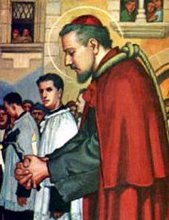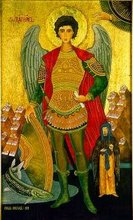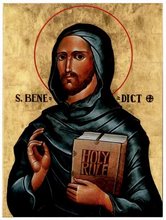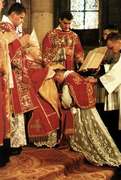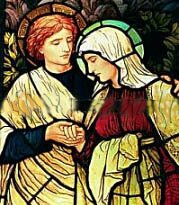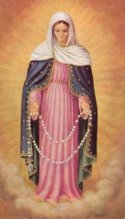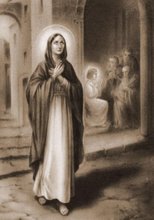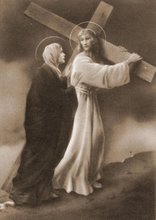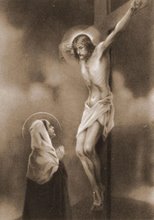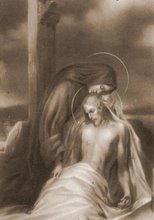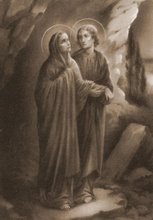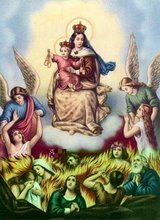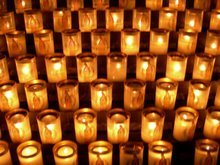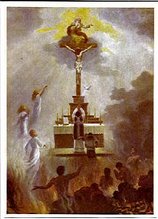
Tuesday, November 25, 2008
Missing Holy Relic

Beautiful Mary Holding Jesus II
Our Lady of Sorrows at the Hour of our Death
 (picture source)
(picture source)Holy Mass

Monday, November 24, 2008
St. Winifred

Thursday, November 20, 2008
Lilies of the Valley

Tuesday, November 18, 2008
Beautiful Mary
 Ok, I'm busy and stressed and I just need sometimes to look upon the beautiful face of Mary and know that she is the Queen of Heaven and I am so honored and so unworthy to have her as my intercessor. Thank you Mary Mother of God for all your prayers, all your suffering on behalf of us poor sinners. I place all my worries and cares at your feet as so many peices of straw.
Ok, I'm busy and stressed and I just need sometimes to look upon the beautiful face of Mary and know that she is the Queen of Heaven and I am so honored and so unworthy to have her as my intercessor. Thank you Mary Mother of God for all your prayers, all your suffering on behalf of us poor sinners. I place all my worries and cares at your feet as so many peices of straw.Monday, November 17, 2008
Purgatorian Archconfraternity

“Oh no! That is not sufficient. It is the Blood of Jesus Christthat is needed to extinguish the flames by which I am consumed;it is the August Sacrifice that will deliver me from these frightful torments.”
(A Soul from Purgatory to Bl. Henry Suso)
Friday, November 14, 2008
Persecution cometh...
Thursday, November 13, 2008
Prayer invoking Mary's Tears

Healer of the sorrows of Eve, change my day of anguish
O you who are blessed among women, help me with your tears
Be solicitous for me for I am miserable.
Tuesday, November 11, 2008
Indulgences for Dummies
 (photo credit to Micki at Holy Cards for your Inspiration)
(photo credit to Micki at Holy Cards for your Inspiration)Monday, November 10, 2008
What are Indulgences?

Friday, November 7, 2008
How to Help the Holy Souls

Thursday, November 6, 2008
Beautiful Holy Card

Another simply incredible holy card from Micki and Holy Cards for your Inspiration. And this right after returning from a week in Nashville!
What Does it Mean to Pray for the Poor Souls?

~We can offer our bodily pains in expiation for their sins.
~We can offer our spiritual sufferings, our disappointments and fears, our discouragement and estrangement from those we love.
~We can offer our vocal prayers, like the Rosary, the Memorare, the Angelus, the recitation of the Divine Office.
~We can offer our mental prayers, like the Way of the Cross, our daily meditation and examination of conscience.
~We can offer our mortifications, like giving up some delicacy at table, or performance of some unpleasant work.
May I offer a recommendation? During the month of November, I suggest that we make a list of all the deceased persons whom we wish to specially remember in our Masses, prayers and sacrifices for the repose of their souls. Add to this list as those enter eternity whom you wish to specially commend to the mercy of God. This, by the way, is called a Necrology. Every Catholic diocese in the world has a Necrology of its deceased priests. Every family should have its own Necrology of deceased members whom we daily remember to our merciful Lord.
Every time you say the grace after meals, be sure to add the invocation, "May the souls of the faithful departed, through the mercy of God, rest in peace. Amen." In every Rosary you recite, do not forget to say after each decade, " O, my Jesus, forgive us our sins, save us from the fires of hell, and bring all souls to heaven, especially those who are in most need of thy mercy."
Remember that devotion to the Poor Souls is really a covenant between them and us. We pray and sacrifice for them, They can pray and suffer for us. They appreciate whatever help we give them, to lessen their suffering and to shorten their stay in Purgatory. They will continue to show their appreciation when we join them in a heavenly eternity.
Tuesday, November 4, 2008
The Truth about Liberalism

John 14:2 In my Father's house are many rooms; if it were not so, I would have told you. I am going there to prepare a place for you.
John 14:3 And if I go and prepare a place for you, I will come back and take you to be with me that you also may be where I am.
John 14:4 You know the way to the place where I am going."
John 14:5 Thomas said to him, "Lord, we don't know where you are going, so how can we know the way?"
John 14:6 Jesus answered, "I am the way and the truth and the life. No one comes to the Father except through me.
The Two Sides of Purgatory

On their side, the Poor Souls are united with us in the one Kingdom of Christ. They can pray and obtain blessings for us here on earth. They are united, as the Second Vatican Council teaches, with the pilgrim Church in the Communion of Saints. We are therefore encouraged to invoke their aid, with a confidence of being heard by those who understand our needs. They know from their own experience what it means to carry the cross here on earth.
On our side we are to do everything we can to help the Poor Souls in the Church Suffering. The sufferings in purgatory are not the same for all. They depend on each person's degree of sinfulness. St. Thomas Aquinas held that the least pain in purgatory is greater than the worst pain in this life. St. Bonaventure held that the worst suffering after death was greater than the worst suffering on earth, but the same could not be said regarding the least pain in purgatory. In general, however, we should say that the pains of purgatory are greater than those on earth.
To atone for your sins...

Monday, November 3, 2008
Why are Souls in Purgatory?

Mortal sins are called mortal because they deprive the sinner of sanctifying grace and the right to heaven. Mortal sins also incur the debt of eternal punishment.
When mortal sins are forgiven in the sacrament of penance, sanctifying grace is restored and the debt of eternal punishment is removed. But normally there is still temporal punishment to be expiated. Moreover, venial sins always carry with them a debt of temporal punishment, which is more or less remitted, depending on a person's spiritual dispositions.
This immediately tells us that because we are sinners we must expect to suffer in expiation for our sins. The choice we have is between patiently suffering here on earth or suffering in purgatory after our bodily death.
November if the Month of the Holy Souls

The Poor Souls are the souls of those people who died in the friendship of God. But they still have some suffering to undergo for the sins they had committed during their lives on earth. It is the infallible teaching of the Catholic Church that there is a purgatory. As the word itself indicates, purgatory is the state of those who still have to be cleansed of the penalty which they owe for their past offenses against God.
The Poor Souls are poor because they are in suffering and need our help. We know from Sacred Scripture that there is a purgatory, as described in the second book of Maccabees, which unfortunately has been removed from the Protestant Old Testament. As described in Sacred Scripture, Judas Maccabeus, the leader of a Jewish army, decided to offer a sacrifice for the Jews who had died in battle. The Bible then tells us,"If he had not expected the fallen to rise again, it would have been superstitious and foolish to pray for the dead." However, since he believed in the resurrection of the dead, "he had this atonement sacrifice offered for the dead, so that they might be released from their sins" (II Maccabees 12:41?45).
The existence of purgatory is a defined truth of the Catholic faith. Those who die without the guilt of mortal sin, but with temporal punishment still due for their past offenses "are cleansed after death in purgatorial or cleansing punishments."
It is commonly believed that the principal suffering in purgatory is the pain of loss. The souls are temporarily deprived of the Beatific Vision.
Wednesday, October 22, 2008
Holy Sonnet


Going out of town

Monday, October 20, 2008
Would like your input...

Friday, October 17, 2008
A Challenge for the World

Thursday, October 16, 2008
Tuesday, October 14, 2008
St. Agnes of Rome ~ My Daughter's Paton Saint


St Agnes Virgin Martyr
Holy Agnes was martyred on 21st January c305 AD in the Piazza Navona in Rome, at the tender age of twelve or thirteen. The son of the Governor of Rome proposed marriage, but Agnes preferred virginity. Her refusal to accept his hand, sent the Governor into a rage, and he threatened to expose Agnes’s parents as Christians, and so face certain death. He tried to persuade Agnes to change her mind by making her walk naked through the city, but her hair miraculously grew to cover her body and save her nakedness. This could not change her mind, so Agnes was burned at the stake, but the flames refused to touch her. She was sent to the lions, who made no attack on her. The son of the Governor goaded the lions who then attacked and killed him. The Father, distraught at his son’s death, pleaded with Agnes to pray for him, and at her intercession he was restored to health. Undeterred, the Governor had Agnes beheaded. Her body was buried in the Catacombs outside the city. On the octave day, she appeared in a vision, full of assurance of her well-being.
Her preference of death, rather than any violation to her young sacred body won her much renown in the early Church, most especially in Europe.
Her severed head is in the Church of Sant’ Agnese in Agone in the Piazza Navona. Her body is in the Basilica of Sant’ Agnese fuori le Mura (St Agnes outside the Walls) on the Via Nomentana.
Because of the resemblance of her name, Agnes to agnus (latin for lamb) she is often represented in Art carrying a lamb. And, on her feast day in the Basilica of St Agnes the Holy Father blesses lambs, from which the sisters of St Agnes’ convent make the Sacred Pallia, worn by Archbishops. Once the Pallia are made, they rest above the tomb of St Peter in the Vatican, from where new Archbishops receive them from the Holy Father.
We celebrate with her and all the saints, their victory over death and suffering through Jesus. We also pray and hope that we will be amongst their number and remain loyal to the faith which she professed, live and died by.
Holy Agnes, pray for us and for my daughter until she stand beside you in heaven!

Friday, October 10, 2008
Stay Awake!
Thursday, October 9, 2008
Catholic England V - St. Edmund, Martyr

"Entirely medieval in spirit though are the inscriptions at the top of the scene. Around Edmund’s head, angelic hands (the one at the left clearer) hold a continuous scroll. Only the word ‘Edmund’ to the left of the tree’s foliage is readable, but the rest of the sentence probably identified him fully as martyred King of the East Angles. The second scroll on the right, curving around the head, shoulders and elbow of the upper right-hand archer, reads ‘Heven blyß to his mede, hym s[h]all have for hys gud de[de]...’. "
Tuesday, October 7, 2008
Catholic England IV - St. Edmund, Martyr


After giving the head and body a speedy burial, the kingdom rebuilt itself for several years before finally erecting a church worthy of Edmund's burial. Legend told that upon exhumation of the body, a miracle was discovered. All the arrow wounds upon Edmund's corpse were healed and his head reattached to his body. The only evidence of his previous decapitation was a thin, red line around his neck. Despite being buried for many years in a flimsy coffin, his skin was soft and fresh as if he were merely sleeping the entire time.
In Percy Dearmer's The Little Lives of the Saints, we are told of Edmund's posthumous revenge on the Danes:
“...the last heathen Danish king, Sweyen (the father of Canute), tried to destroy (Bury St Edmunds). He laid siege to it, and demanded all the treasure of the church, else he threatened to destroy the church and kill all the clergy; and this he said with many taunting words about the saint who lay buried there. But as he was sitting on his war–horse, waiting to attack the town, he saw in the sky St Edmund coming towards him, a crown on his head and a long bright lance in his hand. 'Help, friends!' he cried. 'Edmund is coming to kill me!' Then he fell down, and died in convulsions.”
Sweyn's son, King Canute, converted to Christianity and rebuilt the abbey at Bury St Edmunds. In 1020, he made a pilgrimage there and offered his own crown upon the shrine as atonement for the sins of his forefathers.






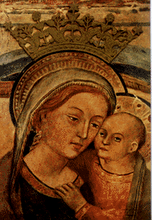
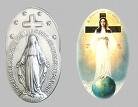

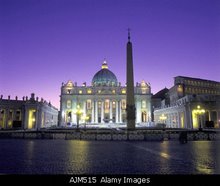

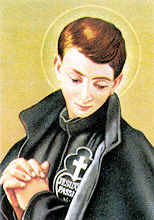
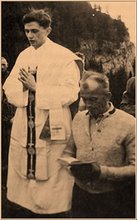
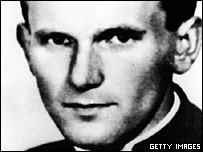
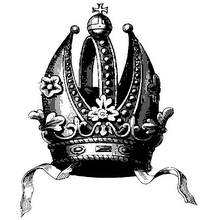
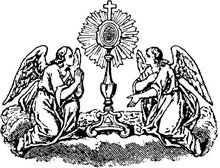
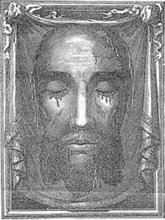


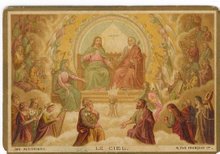




01.jpg)


